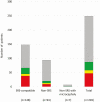Role of Imprinting Disorders in Short Children Born SGA and Silver-Russell Syndrome Spectrum
- PMID: 33236057
- PMCID: PMC7947753
- DOI: 10.1210/clinem/dgaa856
Role of Imprinting Disorders in Short Children Born SGA and Silver-Russell Syndrome Spectrum
Abstract
Background: (Epi)genetic disorders associated with small-for-gestational-age with short stature (SGA-SS) include imprinting disorders (IDs). Silver-Russell syndrome (SRS) is a representative ID in SGA-SS and has heterogenous (epi)genetic causes.
Subjects and methods: To clarify the contribution of IDs to SGA-SS and the molecular and phenotypic spectrum of SRS, we recruited 269 patients with SGA-SS, consisting of 103 and 166 patients referred to us for genetic testing for SGA-SS and SRS, respectively. After excluding 20 patients with structural abnormalities detected by comparative genomic hybridization analysis using catalog array, 249 patients were classified into 3 subgroups based on the Netchine-Harbison clinical scoring system (NH-CSS), SRS diagnostic criteria. We screened various IDs by methylation analysis for differentially methylated regions (DMRs) related to known IDs. We also performed clinical analysis.
Results: These 249 patients with SGA-SS were classified into the "SRS-compatible group" (n = 148), the "non-SRS with normocephaly or relative macrocephaly at birth group" (non-SRS group) (n = 94), or the "non-SRS with relative microcephaly at birth group" (non-SRS with microcephaly group) (n = 7). The 44.6% of patients in the "SRS-compatible group," 21.3% of patients in the "non-SRS group," and 14.3% in the "non-SRS with microcephaly group" had various IDs. Loss of methylation of the H19/IGF2:intergenic-DMR and uniparental disomy chromosome 7, being major genetic causes of SRS, was detected in 30.4% of patients in the "SRS-compatible group" and in 13.8% of patients in the "non-SRS group."
Conclusion: We clarified the contribution of IDs as (epi)genetic causes of SGA-SS and the molecular and phenotypic spectrum of SRS. Various IDs constitute underlying factors for SGA-SS, including SRS.
Keywords: SGA; Silver-Russell syndrome; imprinting disorder; short stature.
© The Author(s) 2020. Published by Oxford University Press on behalf of the Endocrine Society.
Figures


Similar articles
-
Genetic heterogeneity of patients with suspected Silver-Russell syndrome: genome-wide copy number analysis in 82 patients without imprinting defects.Clin Epigenetics. 2017 May 15;9:52. doi: 10.1186/s13148-017-0350-6. eCollection 2017. Clin Epigenetics. 2017. PMID: 28515796 Free PMC article.
-
Contribution of gene mutations to Silver-Russell syndrome phenotype: multigene sequencing analysis in 92 etiology-unknown patients.Clin Epigenetics. 2020 Jun 16;12(1):86. doi: 10.1186/s13148-020-00865-x. Clin Epigenetics. 2020. PMID: 32546215 Free PMC article.
-
Pathogenic Copy Number and Sequence Variants in Children Born SGA With Short Stature Without Imprinting Disorders.J Clin Endocrinol Metab. 2022 Jul 14;107(8):e3121-e3133. doi: 10.1210/clinem/dgac319. J Clin Endocrinol Metab. 2022. PMID: 35583390
-
New clinical and molecular insights into Silver-Russell syndrome.Curr Opin Pediatr. 2016 Aug;28(4):529-35. doi: 10.1097/MOP.0000000000000379. Curr Opin Pediatr. 2016. PMID: 27386972 Review.
-
Approach to the Patient With Suspected Silver-Russell Syndrome.J Clin Endocrinol Metab. 2024 Sep 16;109(10):e1889-e1901. doi: 10.1210/clinem/dgae423. J Clin Endocrinol Metab. 2024. PMID: 38888172 Free PMC article. Review.
Cited by
-
Comprehensive molecular and clinical findings in 29 patients with multi-locus imprinting disturbance.Clin Epigenetics. 2024 Oct 5;16(1):138. doi: 10.1186/s13148-024-01744-5. Clin Epigenetics. 2024. PMID: 39369220 Free PMC article.
-
Association between imprinting disorders and assisted reproductive technologies.Epigenomics. 2025 Apr;17(6):397-410. doi: 10.1080/17501911.2025.2471269. Epub 2025 Mar 3. Epigenomics. 2025. PMID: 40033833 Free PMC article. Review.
-
Clinical Profiles and Genetic Spectra of 814 Chinese Children With Short Stature.J Clin Endocrinol Metab. 2022 Mar 24;107(4):972-985. doi: 10.1210/clinem/dgab863. J Clin Endocrinol Metab. 2022. PMID: 34850017 Free PMC article.
-
Factors affecting growth hormone treatment in short stature children born small for gestational age in China: a single-centre, real-world study.Endocrine. 2024 Dec;86(3):1121-1130. doi: 10.1007/s12020-024-04009-6. Epub 2024 Aug 29. Endocrine. 2024. PMID: 39210232
-
Maternal uniparental disomy of chromosome 7: how chromosome 7-encoded imprinted genes contribute to the Silver-Russell phenotype.Clin Epigenetics. 2025 Apr 30;17(1):70. doi: 10.1186/s13148-025-01867-3. Clin Epigenetics. 2025. PMID: 40307819 Free PMC article.
References
-
- Finken MJJ, van der Steen M, Smeets CCJ, et al. Children born small for gestational age: differential diagnosis, molecular genetic evaluation, and implications. Endocr Rev. 2018;39(6):851-894. - PubMed
-
- Stalman SE, Solanky N, Ishida M, et al. Genetic analyses in small-for-gestational-age newborns. J Clin Endocrinol Metab. 2018;103(3):917-925. - PubMed
-
- Clayton PE, Cianfarani S, Czernichow P, Johannsson G, Rapaport R, Rogol A. Management of the child born small for gestational age through to adulthood: a consensus statement of the International Societies of Pediatric Endocrinology and the Growth Hormone Research Society. J Clin Endocrinol Metab. 2007;92(3):804-810. - PubMed
-
- Lee PA, Chernausek SD, Hokken-Koelega ACS, Czernichow P. International Small for Gestational Age Advisory Board consensus development conference statement: management of short children born small for gestational age, April 24–October 1, 2001. Pediatrics. 2003;111(6 Pt 1):1253-1261. - PubMed
Publication types
MeSH terms
Substances
LinkOut - more resources
Full Text Sources
Medical
Miscellaneous

